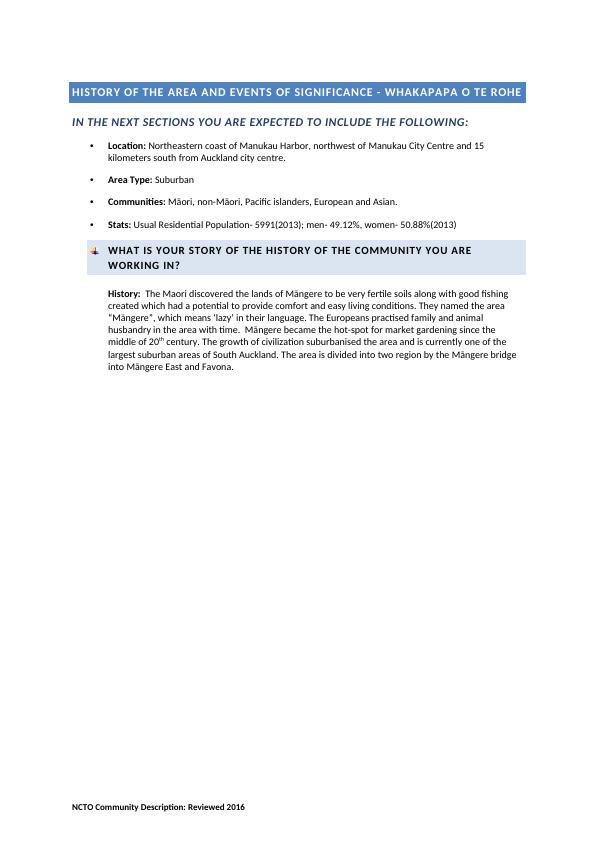The New Zealand Health Strategy - PDF
Added on 2021-04-17
9 Pages1524 Words63 Views
COMMUNITY DESCRIPTIONNAME OF COMMUNITY:YEAR OF DESCRIPTION:NAME OF AUTHOR:NCTO Community Description: Reviewed 2016

HISTORY OF THE AREA AND EVENTS OF SIGNIFICANCE - WHAKAPAPA O TE ROHEIN THE NEXT SECTIONS YOU ARE EXPECTED TO INCLUDE THE FOLLOWING:•Location:Northeastern coast of Manukau Harbor, northwest ofManukau City Centreand 15 kilometers south fromAuckland city centre. •Area Type: Suburban •Communities: Māori, non-Māori, Pacific islanders, European and Asian. •Stats: Usual Residential Population- 5991(2013); men- 49.12%, women- 50.88%(2013)WHAT IS YOUR STORY OF THE HISTORY OF THE COMMUNITY YOU ARE WORKING IN?History: The Maori discovered the lands of Māngere to be very fertile soils along with good fishing created which had a potential to provide comfort and easy living conditions. They named the area “Māngere”, which means ‘lazy’ in their language. The Europeans practised family and animal husbandry in the area with time. Māngere became the hot-spot for market gardening since the middle of 20th century. The growth of civilization suburbanised the area and is currently one of the largest suburban areas of South Auckland. The area is divided into two region by the Māngere bridge into Māngere East and Favona.NCTO Community Description: Reviewed 2016

PLEASE PROVIDE A REFLECTION ON YOUR COMMUNITY TODAY USING THE LATEST STATISTICAL DATAThe Statistics New Zealand website may be helpful for your reflection: http://www.stats.govt.nz/Census/2013-census/profile-and-summary-reports/quickstats-about-a-place.aspxEthnic groups: European (21.4%), Maori (14.4%), Pacific People ( 46.2%), Asian (32.5%), Middle Eastern, Latin American, African(0.6%) and other ethnicity (0.5%)Cultural Groups: Polynesian and EuropeanFamily types: 49.7% of all families are Couples with Children. 25.3% are one parent with children.Transport :Public: Railway, bus and motorsPrivate: 26.3% of local civilians have access to 2 or 3 motor vehicles Type of dwelling:Renting:About a hundred houses in totalOwn home: 46.6%Living with extended family: 58.2% with two or more generationsHousehold overcrowding: 12.9% households contain 180 people instead of approximately 4.Employment: 15.5% are unemployed over the age of 15 years.Occupations: Professionals and labourers.Parental Education: 74.7% of above 15 years have formal qualification. 12.1% have bachelor’s degree or higher.Income: 45% of people aged above 15 have annual income less of equal to $20,000. 16.5% have more than $50,000 annually.NCTO Community Description: Reviewed 2016

End of preview
Want to access all the pages? Upload your documents or become a member.
Related Documents
Health Inequality in New Zealandlg...
|22
|4748
|251
Community and Health Assignmentlg...
|5
|929
|77
